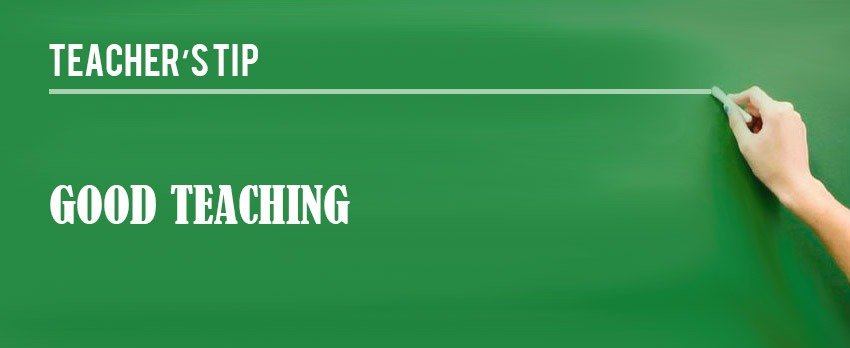Good Teaching

GOOD TEACHING
I’d like to talk briefly about good teaching. I fear doing this,knowing well how fine teachers differ as their characters and styles differ. Idiosyncrasy is a virtue to the extent that successful teaching rests on character – and I believe it heavily rests there. By describing a generalized view of good teaching, I may unintentionally signal to you an intolerance of idiosyncrasy. I do not wish to do so.
I am also concerned that I may give the impression that I think teaching per se is important. Of course, it isn’t; what is only important is what the students learn. By speaking of teaching, I hope I won’t muddy the truism that our actions as instructors are a means to an end — a pupil’s knowledge — rather than an end in themselves.
However, with these reservations expressed, let me proceed. Brilliant teaching, in my view, at its heart reflects scholarship, personal integrity and the ability to communicate with the young.
Scholarship is both the grasp of a realm of knowledge and a habit of mind. An effective teacher provokes both from his students. But particularly the latter, as it is a habit of mind, rather than facts, which endure in a person over a lifetime. Scholarship is not only an affair of the classroom, but, at its best, is a way of life, one which is marked by respect for evidence and for logic, by inquisitiveness and the genius to find new meaning in familiar data, and by the ability to see things in context, to relate specificities to generalities, facts to theories, and theories to facts.
The second characteristic of great teaching is integrity, in at least two of its separate meanings. First there is probity: characteristics of honesty, principle and decent candour. These qualities are fundamental, of course, to the good life for anyone, but they play a special role in the behaviour of those of us who inevitably, as we live together with them, influence younger people by our example.
Another, but equally important, kind of integrity is completeness or unity of character, the sense of self-confidence and personal identity a fine teacher exhibits. There is much pop jargon around to describe this, some of it useful: “knowing who you are,” “getting it together,” “not losing one’s cool.” Because they are teenagers, most of our students’ most painful trials are in finding their own selves, in gaining proper self-confidence, and they look to us as people who have learned to control the ambiguities, pressures and restrictions of life rather than having them control us. A fine teacher is not particularly one who exudes self-confidence from every pore — a superperson (more likely, a hypocrite!). Far from it. A fine teacher does have confidence, but the honest confidence that flows from a fair recognition of one’s own frailties as well as talents and which accommodates both joyfully. The lack of assurance that typically marks adolescence and that takes observable form in pettiness, distortion, scapegoating, over-reacting, or withdrawal ideally is balanced in a school by the presence of adults who have grown to channel and control these sturdily persistent human traits. A teenager leans little from older folk, of whatever scholarly brilliance, who as people are themselves yet teenagers.
The ability to communicate with the young is the third basic characteristic of good teaching. It means, obviously, liking young people, enjoying their noisy exuberance and intense questioning, which is their process of growing up. It means the ability to empathize, to see a situation as the student sees it. A good teacher must be, obviously, a compulsive listener. It means the skill of
provoking more out of a student than he believed possible, of knowing the tests to which to put a young scholar in order that he be convinced of his own learning and to lure him into further learning. It means a belief in the dignity of young people and in the stage of life at which they now find themselves. Great teachers neither mock nor underestimate the young.
I am intensely aware that the foregoing description sounds pretentious and begs specificity. I won’t apologize for the pretension. I believe these goals are both achievable and proper for each of us as professional teachers to hold. Lesser goals, or more pragmatic goals demean us, I believe, and would suggest that the teacher’s craft is less human and more mechanical than it properly should be. But I do recognize that lack of specificity, and respond to it by recounting some little incidents and practices I’ve observed among members of this assembled company. Acts which may appear trivial in themselves, but which, when added to the hundreds of similar acts, create a standard and a style from which young people can learn.
For example, here are some apparent minutiae:
- Knowing student’s names, and calling them by name.
- Greeting students and colleagues pleasantly.
- Going to see student friends on varied occasions (i.e., the House Counselor or teacher, attending a game or play because of a youngster who’s playing).
- Remembering something that had earlier worried a student, and asking about it (“Is your mother recovering from her operation?”).
- Resisting the sarcastic, if funny, bon mot that could be an amusing but hurtful rejoinder to a foolish comment a student has just made in class.
- Never tolerating ad hominem remarks among students and colleagues, such as apparently benign but really insulting jokes arising from one’s sex or ethnic origin.
- Scrupulously following the dictum which all our parents taught us: “If you can’t say anything good about someone, don’t say anything at all.”
- Telling a student the unvarnished truth, privately (i.e., “Susan, I honestly suspect you…”, “George, you’re not working hard enough.”, “Sam, you are an insult to the olfactory nerves; go take a shower.”, “Joan, you’re a bully.”).
I could go on, but I trust the point is clear; such actions signal the importance a teacher feels for an individual, for his dignity and for his growth.
Some others; minutiae, of a different sort:
- Always insisting on the reasons for things — in class and out — and always taking time, one’s self, to give reasons. This takes patience, indeed stretches it often to Biblical extremes.
- Knowing the difference between asking students to listen to you and to hear you – and acting upon it.
- “Hearing” students, and questioning them thoroughly enough to know just how they see or are confused by an issue.
- Showing that you can change your mind, when evidence and logic suggest it.
- Being on the edge of your subject and int.
- Always insisting on the reasons for things — in class and out — and always taking time, one’s self, to give reasons. This takes patience, indeed stretches it often to Biblical extremes.
- Knowing the difference between asking students to listen to you and to hear you – and acting upon it.
- “Hearing” students, and questioning them thoroughly enough to know just how they see or are confused by an issue.
- Showing that you can change your mind, when evidence and logic suggest it.
- Being on the edge of your subject and int.
The point here is obvious, the need to help students develop rational habits of mind and a sense of the joy of inquiry.
Some others, apparent trivia:
- Never being late to class or cutting it for some personal convenience.
- Returning papers to students within twenty-four hours.
- Insisting on neat written work, delivered on schedule.
- Insisting on a formality of conduct in a classroom comparable to the formality of thought implicit in the subject being studied.
- Clearly signalling the imperative of scrupulous intellectual honesty.
- Insisting on clear thinking and fair-mindedness in the dormitory, on the Playing field and elsewhere, as expected in the classroom.
- Perceiving the results of a class as “My students know XYZ,” rather than “I covered XYZ in class” – and knowing the difference between the two.
The message here unequivocally is the deep seriousness we have for intellectual values and for learning.
Some other minutiae; ones that help students to grow:
- Always expect a bit more of a student than he expects of himself
- Accentuate the positive; be careful always to praise good work. No one learns anything faster than when he feels he is successful
- Exhibit the greatest possible friendliness that one can honestly exhibit to a student one doesn’t like, and try to repress personal annoyances
- Be friends with students, but not buddies; the obligations of the latter relationship limit one’s freedom to teach well
- Never give up on a student, or categorize or ‘brand’ him permanently
One can go on, and we should go on among ourselves all year. I admit that this definition of teaching — a mix of scholarship, integrity and the gift of communicating with the young — is in its generality often as difficult to categorize as it is to describe. It turns on a person’s style, character. We mustn’t be afraid to confront this fact, and deal with it.
I take heart in this situation by recalling the consternation of some university colleagues of mine when they discovered a persistently inconsistent hiccup in their masses of research data on students’ school performance, a hiccup of excellence that could be explained by the fact that the teachers in a particular school gave a damn. The students in my colleagues’ study shouldn’t have performed well in this — but they did. It’s so much easier for social scientists to explain realities in terms of income level, or ethnic origin, or average ages. But “giving a damn”? Caring about kids? It made a difference, they — but they were embarrassed to admit it. We shouldn’t be embarrassed!




